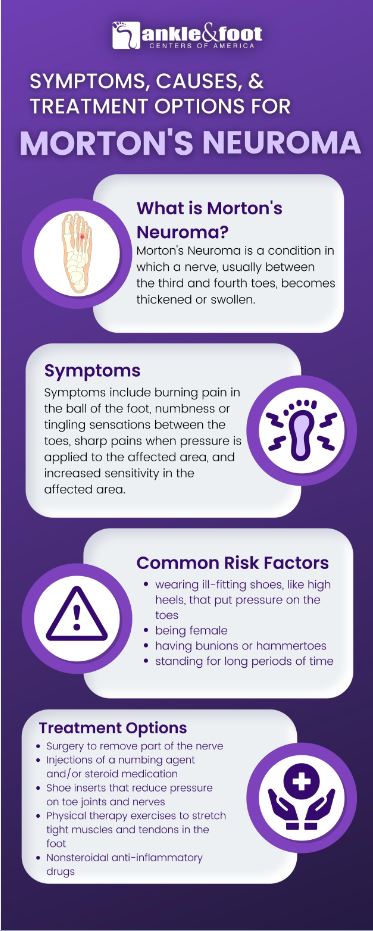What is a Morton’s Neuroma? In this comprehensive guide, we will discuss the causes, symptoms, diagnosis, and treatment options for Morton’s Neuroma, including at-home exercises and surgical procedures. We will also provide tips for finding an expert podiatrist who specializes in nerve pain of the foot and ankle, and strategies for managing the condition long-term.
Table of Contents
What is a Morton’s Neuroma?
 Morton’s Neuroma is a painful condition that affects the ball of the foot, often causing sharp, burning, and tingling sensations. The condition is caused by the thickening of the tissue around a nerve that leads to your toes. It is often described as feeling like you are standing on a pebble, even when there is no foreign object present. Morton’s Neuroma can be debilitating and affect your daily activities, but with the right care and treatment, you can manage the symptoms and improve your quality of life.
Morton’s Neuroma is a painful condition that affects the ball of the foot, often causing sharp, burning, and tingling sensations. The condition is caused by the thickening of the tissue around a nerve that leads to your toes. It is often described as feeling like you are standing on a pebble, even when there is no foreign object present. Morton’s Neuroma can be debilitating and affect your daily activities, but with the right care and treatment, you can manage the symptoms and improve your quality of life.
Causes of Morton’s Neuroma
Morton’s Neuroma is caused by the thickening of the tissue around a nerve that leads to your toes. The thickened tissue can be caused by a variety of factors, including:
- Footwear: High heels or shoes that are too tight can increase pressure on the ball of your foot and cause Morton’s Neuroma.
- Foot deformities: Structural issues, such as high arches or flat feet, can increase your risk of developing Morton’s Neuroma.
- Repetitive stress: Activities that involve repetitive stress on the foot, such as running or jumping, can increase your risk of developing Morton’s Neuroma.
- Injuries: Injuries to the foot or ankle can lead to the development of Morton’s Neuroma.
Symptoms of Morton’s Neuroma
The symptoms of Morton’s Neuroma include:
- Sharp, burning, or tingling pain in the ball of the foot.
- A feeling of a lump or foreign object in the ball of the foot.
- Numbness or a lack of feeling in the toes.
- Pain that worsens with activity or when wearing tight shoes.
Diagnosing Morton’s Neuroma
To diagnose Morton’s Neuroma, your podiatrist will perform a physical exam and may order imaging tests, such as an X-ray or MRI, to confirm the diagnosis. Your podiatrist may also conduct a nerve conduction study to evaluate the function of the nerve and determine the severity of the condition.

Treatment options for Morton’s Neuroma
There are several Morton’s Neuroma treatment options available, including:
- At-home exercises: At-home exercises, such as toe stretches, arch stretches, and ankle circles, can help alleviate the pain and discomfort associated with Morton’s Neuroma. These exercises can improve the flexibility and mobility of the foot, reducing the pressure on the affected nerve.
- Shoe modifications: Changing your footwear can help reduce the pressure on the ball of your foot and alleviate the symptoms of Morton’s Neuroma. Look for shoes with a wider toe box, low heels, and good arch support.
- Custom orthotics: Custom orthotics can provide additional support and cushioning to the foot, reducing the pressure on the affected nerve.
- Medications: Over-the-counter pain medications, such as ibuprofen, can help reduce pain and inflammation associated with Morton’s Neuroma.
- Corticosteroid injections: Corticosteroid injections can help reduce pain and inflammation in the affected area. However, these injections should be used sparingly, as they can have side effects and may not be effective long-term.
- Surgery: In severe cases, surgery may be necessary to remove the thickened tissue around the nerve. Morton’s Neuroma Surgery is typically performed as an outpatient procedure, and patients can usually go home the same day.
Finding an Expert Podiatrist
When looking for a podiatrist to treat your Morton’s Neuroma, it’s important to find someone who specializes in nerve pain of the foot and ankle. You want a podiatrist who has experience diagnosing and treating Morton’s Neuroma, and who can develop a personalized treatment plan that addresses your specific needs.
You may want to start by asking for referrals from your primary care physician or from friends or family members who have received treatment for a similar condition. You can also search for podiatrists online and read reviews from previous patients.
During your initial consultation with the podiatrist, ask about their experience treating Morton’s Neuroma and their treatment philosophy. Make sure you feel comfortable with the podiatrist and that they take the time to answer all of your questions.

Managing Morton’s Neuroma Long-Term
 Managing this condition long-term involves a combination of proper footwear, Morton’s Neuroma Exercises at home, and regular visits to your podiatrist. It’s important to wear shoes with a wider toe box, low heels, and good arch support to reduce the pressure on the ball of your foot. You should also continue to do at-home exercises to maintain the flexibility and mobility of your foot.
Managing this condition long-term involves a combination of proper footwear, Morton’s Neuroma Exercises at home, and regular visits to your podiatrist. It’s important to wear shoes with a wider toe box, low heels, and good arch support to reduce the pressure on the ball of your foot. You should also continue to do at-home exercises to maintain the flexibility and mobility of your foot.
Regular visits to your podiatrist can help monitor your condition and adjust your treatment plan as necessary. Your podiatrist can also provide additional tips for managing the condition long-term, such as managing your weight and avoiding high-impact activities that can worsen your symptoms.
Conclusion
Morton’s Neuroma can be a painful and debilitating condition, but with the right care and treatment, you can manage the symptoms and improve your quality of life. At-home exercises, shoe modifications, custom orthotics, medications, and surgery are all treatment options available for Morton’s Neuroma.
By working with an expert podiatrist who specializes in nerve pain of the foot and ankle, you can develop a personalized treatment plan that addresses your specific needs. Managing Morton’s Neuroma long-term involves a combination of proper footwear, at-home exercises, and regular visits to your podiatrist. With the right care and treatment, you can manage Morton’s Neuroma and get back to your daily activities pain-free.





